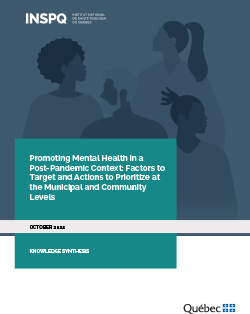Promoting Mental Health in a Post-Pandemic Context: Factors to Target and Actions to Prioritize at the Municipal and Community Levels
The INSPQ was mandated by the Direction générale de la santé publique of the Ministère de la Santé et des Services sociaux to produce a knowledge synthesis of the scientific literature in order to 1) identify, in literature reviews, the factors associated with mental health in the context of a pandemic or a disaster, factors upon which municipalities can take action; and 2) identify actions at the municipal or community level that influence these factors and help promote mental health in the aftermath of a disaster.
The reviews analyzed show a strong convergence on several factors associated with mental health status, including those related to the social environment: social support, taking pro-social actions (e.g., offering support to friends or neighbours during lockdown), social isolation and feelings of loneliness, or restricting contact and periods of confinement. The same is true for factors related to the socioeconomic status of individuals, including income, education, and job insecurity following a disaster. However, only a few reviews focus on the characteristics of the physical environment.
The studies reviewed that present actions at the municipal or community level have the objective of strengthening community resilience while supporting individuals in developing their adaptive capacity and improving their well-being. The majority identify mental health as an asset to be maintained or strengthened. However, none of the studies have robust evaluations of the effects of interventions on mental health; rather, they present observations or formative assessments. These, as well as several characteristics common to the studies, make it possible to identify organizational approaches: having an explicit concern for mental health and putting together a dedicated team; the importance of intersectoral work that includes citizens and local actors in an equal dynamic; ensuring coherence of interventions around the goal of recovery, in particular by adopting a logic model and building on community strengths. Other studies offer examples of direct interventions to the population, including implementing actions that are sensitive to lived realities and promote participation.
Finally, a few observations and courses of action emerge from this synthesis:
- Mental health must be an explicit part of the response and of the preparedness planning response for disasters. It is therefore important to approach it from the perspective of health promotion, which helps foster mental health as well as prevent its deterioration.
- Several factors in the sphere of social interactions are recognized for their influence on mental health in the context of a disaster. Thus, it is important to foster social support and positive social relationships by building on participatory approaches, forming intersectoral mental health teams that include citizens and different groups in the community, while ensuring an equal dynamic among collaborators.
- Targeting neighbourhoods that are particularly affected by a disaster may better address mental health needs. It is crucial to provide a safe physical environment and green spaces that are accessible to all.
- An equity-based approach can guide municipalities in implementing actions to facilitate recovery. Thus, it is important to know the status of populations by having data not only on symptoms of mental disorders, but also on positive mental health and the factors that protect and weaken groups during disasters. Interventions should then be linked to these factors in a strength-based, equity-focused approach to recovery.


